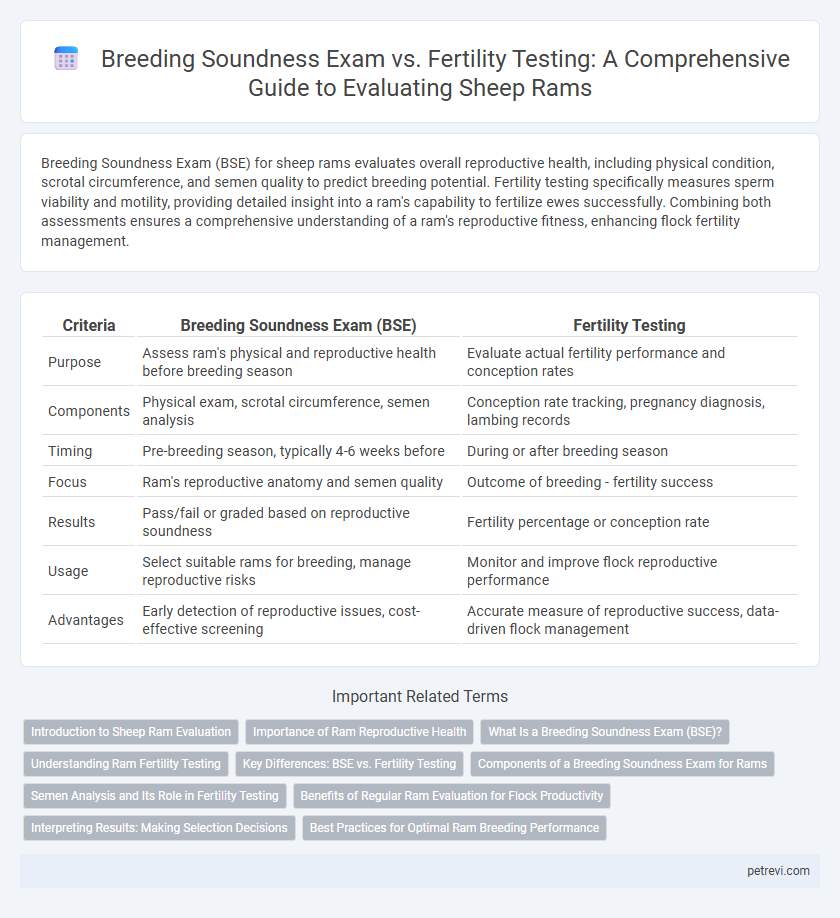Breeding Soundness Exam (BSE) for sheep rams evaluates overall reproductive health, including physical condition, scrotal circumference, and semen quality to predict breeding potential. Fertility testing specifically measures sperm viability and motility, providing detailed insight into a ram's capability to fertilize ewes successfully. Combining both assessments ensures a comprehensive understanding of a ram's reproductive fitness, enhancing flock fertility management.
Table of Comparison
| Criteria | Breeding Soundness Exam (BSE) | Fertility Testing |
|---|---|---|
| Purpose | Assess ram's physical and reproductive health before breeding season | Evaluate actual fertility performance and conception rates |
| Components | Physical exam, scrotal circumference, semen analysis | Conception rate tracking, pregnancy diagnosis, lambing records |
| Timing | Pre-breeding season, typically 4-6 weeks before | During or after breeding season |
| Focus | Ram's reproductive anatomy and semen quality | Outcome of breeding - fertility success |
| Results | Pass/fail or graded based on reproductive soundness | Fertility percentage or conception rate |
| Usage | Select suitable rams for breeding, manage reproductive risks | Monitor and improve flock reproductive performance |
| Advantages | Early detection of reproductive issues, cost-effective screening | Accurate measure of reproductive success, data-driven flock management |
Introduction to Sheep Ram Evaluation
Sheep ram evaluation involves assessing reproductive potential through Breeding Soundness Exam (BSE) and fertility testing, critical for flock productivity. BSE focuses on physical examination, semen quality, and libido, while fertility testing evaluates actual breeding performance and conception rates. Combining both approaches ensures accurate selection of rams for optimal flock genetics and reproductive efficiency.
Importance of Ram Reproductive Health
Breeding Soundness Exams (BSE) provide a comprehensive assessment of a ram's reproductive organs, semen quality, and overall physical condition, serving as a crucial tool to predict fertility potential in sheep flocks. Fertility testing, while often focused on semen analysis alone, may not capture underlying health issues impacting ram performance and breeding success. Ensuring optimal ram reproductive health through regular BSEs enhances flock productivity by minimizing infertility risks and promoting genetic improvement in sheep populations.
What Is a Breeding Soundness Exam (BSE)?
A Breeding Soundness Exam (BSE) is a comprehensive evaluation performed on rams to assess their reproductive potential before the breeding season. This exam includes physical examination, scrotal circumference measurement, semen analysis, and evaluation of libido to ensure optimal fertility. BSE is critical for identifying rams with the best genetic traits and reproductive health, directly impacting flock productivity.
Understanding Ram Fertility Testing
Ram fertility testing encompasses a series of assessments including physical examination, semen evaluation, and libido testing to determine a ram's breeding potential. Breeding Soundness Exam (BSE) specifically evaluates reproductive organs, semen quality, and overall health to predict fertility success. Understanding these tests enhances flock productivity by identifying rams capable of successful mating and conception.
Key Differences: BSE vs. Fertility Testing
Breeding Soundness Exam (BSE) in sheep rams primarily evaluates physical reproductive health, including testicular size, semen quality, and libido, to predict breeding potential. Fertility testing goes beyond BSE by assessing actual reproductive success rates through mating trials or pregnancy outcomes. BSE offers a standardized and immediate evaluation tool, while fertility testing provides longitudinal data on ram performance in flock reproduction.
Components of a Breeding Soundness Exam for Rams
A Breeding Soundness Exam (BSE) for rams includes evaluation of physical health, semen quality, and reproductive anatomy to ensure optimal fertility. Key components include assessment of body condition score, scrotal circumference measurement, and semen analysis for motility, morphology, and concentration. This comprehensive exam provides predictive insight into a ram's ability to successfully breed compared to isolated fertility testing methods.
Semen Analysis and Its Role in Fertility Testing
Semen analysis plays a crucial role in fertility testing by evaluating sperm motility, morphology, and concentration to determine ram reproductive potential. Breeding Soundness Exam (BSE) integrates physical examination and semen analysis, providing a comprehensive assessment of a ram's ability to successfully breed. Accurate semen evaluation helps identify subfertile or infertile rams, improving flock productivity and genetic quality.
Benefits of Regular Ram Evaluation for Flock Productivity
Regular ram evaluation through Breeding Soundness Exams (BSE) ensures optimal reproductive health by assessing semen quality, physical condition, and libido, leading to higher conception rates in sheep flocks. Fertility testing complements BSE by identifying subfertile rams early, reducing the risk of prolonged infertility and improving lambing percentages. Implementing routine evaluations boosts flock productivity by maximizing genetic potential and minimizing breeding failures.
Interpreting Results: Making Selection Decisions
Breeding soundness exams (BSE) for rams provide a comprehensive assessment of physical health, semen quality, and reproductive anatomy, enabling accurate prediction of fertility potential. Fertility testing focuses primarily on sperm motility and morphology but may overlook critical anatomical or health issues impacting breeding success. Interpreting results requires integrating BSE data to select rams with optimal reproductive traits, ensuring higher lambing rates and genetic improvement in flock management.
Best Practices for Optimal Ram Breeding Performance
Breeding Soundness Exam (BSE) and Fertility Testing are critical evaluations to ensure optimal ram breeding performance, focusing on semen quality, physical health, and reproductive anatomy. Implementing routine BSE before and during the breeding season helps detect issues such as poor semen motility, morphological defects, or physical abnormalities that could impair fertility. Combining thorough fertility testing with proper nutrition and management practices maximizes ram reproductive efficiency, contributing to higher flock conception rates and overall sheep herd productivity.
Breeding Soundness Exam vs Fertility Testing for Sheep Ram Evaluation Infographic

 petrevi.com
petrevi.com